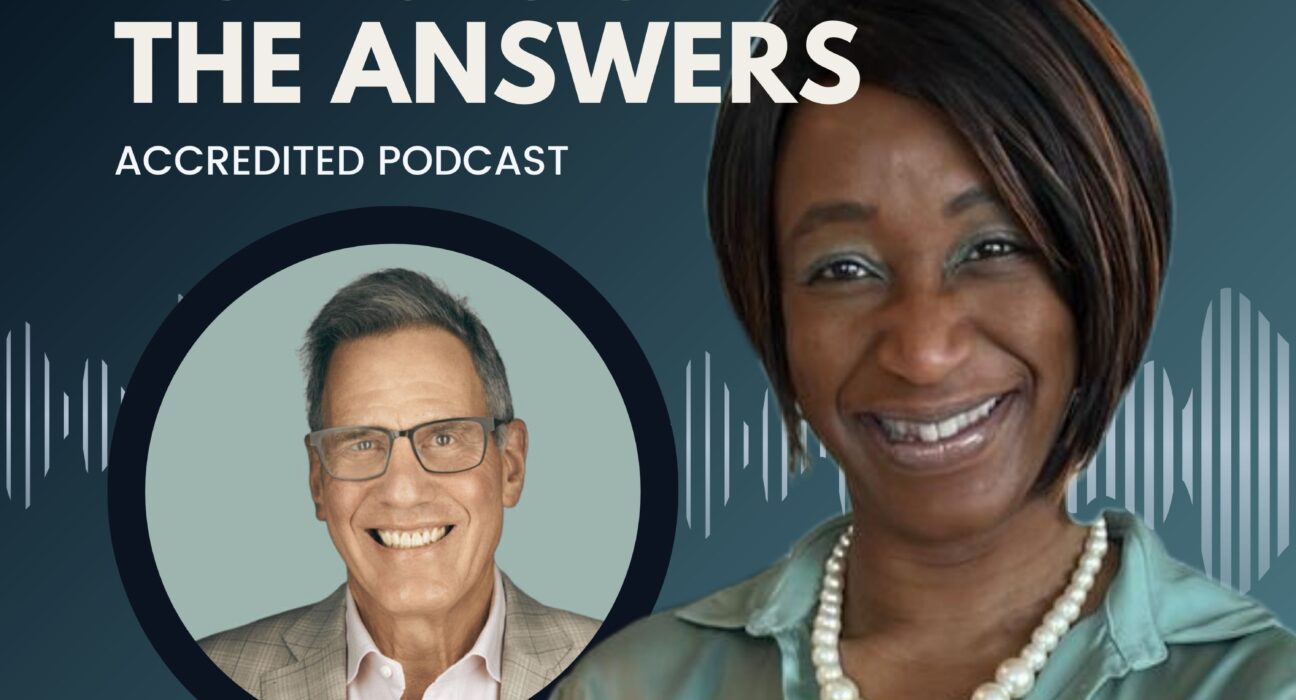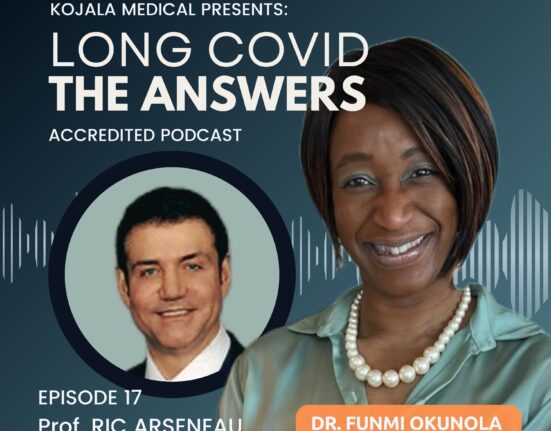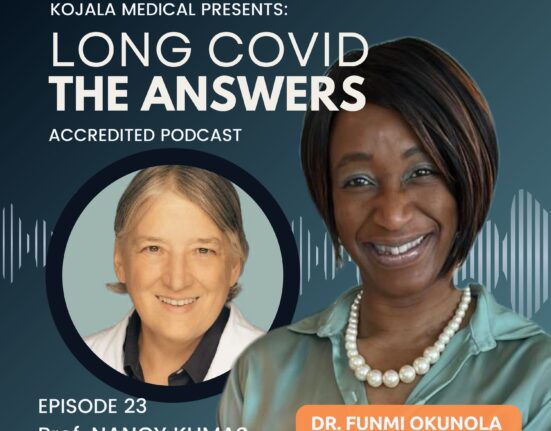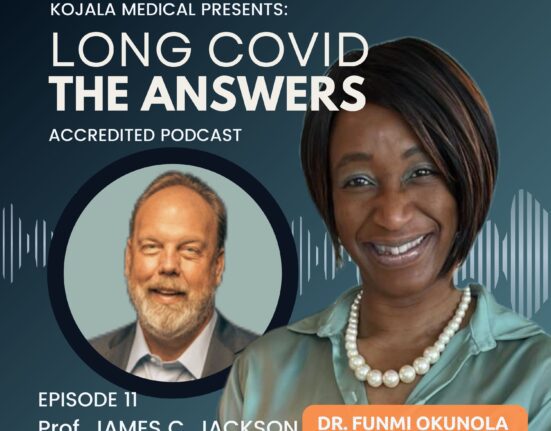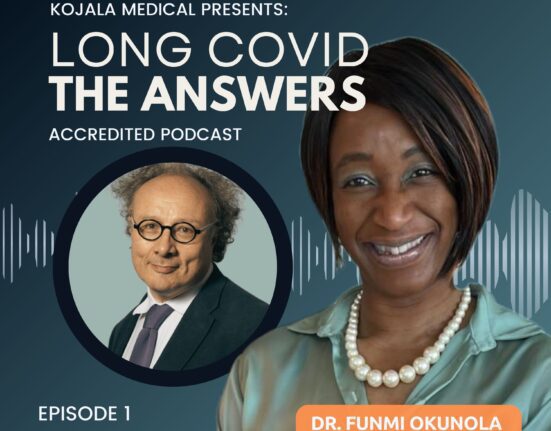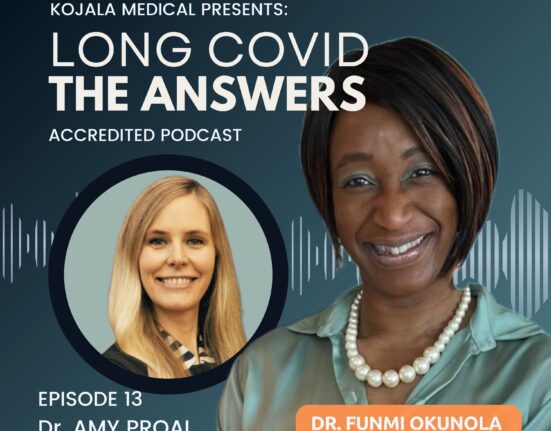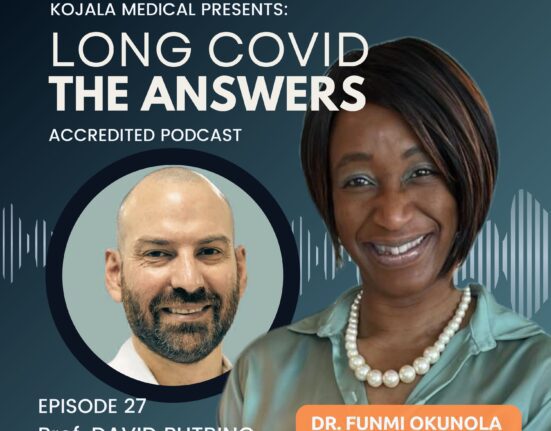
Explore how to tackle misinformation and build trust in underserved communities in this insightful episode with Dr Richard J Baron MD.
Key Questions Discussed:
- How can we effectively address misinformation?
- What role do trusted community leaders play in fostering trust?
- How can health messaging be made more inclusive and relatable?
Watch for a deep dive into impactful communication and authentic connections in public health!
Guest – Dr Richard J. Baron, MD, MACP
Note: The podcast has no bias. All conflicts of interest are highlighted with individual guests.
Healthcare Professionals | Earn 0.5 Certified Mainpro+® Credits! Please register/login to claim your CPD/ CEU credits.
Podcast Overview:
In this insightful podcast, Dr Richard J Baron MD delves into effective strategies for combating health misinformation, building community trust, and creating inclusive health campaigns. Learn how trusted voices and accurate messaging can improve public health outcomes.
Discussions:
- Combating Health Misinformation
- The Role of Trusted Community Leaders
- Strategies for Building Trust
- Inclusive Messaging in Public Health
- Effective Communication Practices for Health Campaigns
DISCLAIMER: The information in this podcast is provided for informational purposes only. You should not use any information discussed in this podcast and related materials to make medical or healthcare related decisions. Always consult a your physician or other qualified health care provider with regards to diagnosing managing your medical condition. Any medications or treatments, including any discussed in this podcast, should be initiated and managed by a qualified health care professional.
Podcast Transcript:
Healthcare Professionals: Please note to claim Certified CPD / CEU credits toward your medical license (Canada & reciprocal CPD/CEU Worldwide), you will need to register or log in.
Episode 21 – Social Media – A Force For Ill Turned To A Force For Good! ft. Dr Richard Baron MD
[00:00:00] Funmi Okunola: The information in this podcast is provided for informational purposes only. You should not use any information discussed in this podcast and related materials to make medical or healthcare related decisions. Always consult your physician or other qualified healthcare provider with regards to diagnosing and managing your medical condition. Any medications or treatments, including any discussed in this podcast should be initiated and managed by a qualified healthcare professional.
Funmi Okunola: [00:00:00] Welcome to Long COVID – The Answers. Today’s Episode is entitled “Social Media – A Force for Ill Turned to A Force for Good.” Today we will explore how social media is used for misinformation and disinformation, and how this can be turned around and become a tool of medical education and advocacy. This Episode is part of a series of Episodes about social media and Long COVID.
I’d like to introduce Dr. Richard J. Baron. Dr. Baron was the President and CEO of the American Board of Internal Medicine and the American Board of Internal Medicine Foundation. Dr. Baron received an English degree from Harvard College and his medical degree from Yale University. He is a board certified internal and geriatric physician.
Dr. Baron has served as Group Director of Seamless Care Models at the Centers for Medicare and Medicaid Services Innovation Center where he led efforts related to accountable care organizations and primary care. He was the architect of the ‘Best Clinical and Administrative [00:01:00] Practices Program’, working with medical leadership of Medicaid health plans around the United States in learning collaboratives to improve the quality of care for their members, which reached more than half of the medical population of the U.S.
Dr. Baron is a member of the Commonwealth Fund Advisory Group on Healthcare Delivery and System Reform, and a member of the Aspen Institute Health Strategy Group which promotes improvements in policy and practice by providing leadership on complex health issues. He has published many papers on the doctor-patient relationship, the falling trust of U.S. citizens in the medical establishment, better delivery of assessment and management of chronic disease in primary care, and more recently the impact of social media on the dissemination of medical information and how healthcare professionals can positively engage with patients through this new medium. Welcome Richard.
Richard Baron: Thank you so much, Funmi. It’s really a pleasure to be with you, and I admire [00:02:00] your focus on this critical subject.
Funmi Okunola: Thank you so much. Richard, do you have any conflicts of interest to declare?
Richard Baron: No. You identified my day job. I’m President and CEO of the American Board of Internal Medicine and the ABIM Foundation, and I don’t have any health-related conflicts other than that.
Funmi Okunola: Great. The reason why I asked Richard to participate in this interview is because ‘COVID-19 – The Answers’ and ‘Long COVID – The Answers’ were formed out of my experience of persistently combating medical myths and disinformation in my work as a family physician. Patients would declare that they heard that having the vaccine would transmit cell phone 5G waves and other bizarre rumors.
Long haulers couldn’t access information about their disease. So, after spending time debunking the farcical, they would then ask me where they could access credible information that they could understand, and I often couldn’t answer them. Richard co-authored a paper entitled [00:03:00] “Addressing Viral Medical Rumors and False or Misleading Information,” published in the Annals of Internal Medicine on the 18th of July 2023.
To quote a line from the paper, “We live in a world of rapid networked communications where traditional linear hierarchies of knowledge generation and dissemination have been permanently disrupted. No longer do scientists generate new knowledge filtered exclusively through peer review that is incorporated into clinical practice guidelines. Instead, medical information is widely shared online, sometimes chaotically, by many people before it can be vetted. This makes it challenging for individuals to know the validity of the information they are consuming in environments of rapidly evolving scientific consensus or uncertainty, such as the emergence of a novel disease, i.e. the coronavirus.” Richard, could you please define [00:04:00] a rumour, misinformation and disinformation?
Richard Baron: Great question. Those three terms are used in confusing ways and often interchangeably. I don’t think that they’re the same. We had originally used the framework of disinformation and misinformation, and the distinction was information that’s not true.
In the case of misinformation, it’s being shared, it’s just wrong. There’s no attribution of intent. In the case of disinformation, there’s an attribution of intent. Someone is deliberately trying to deceive. Well, as you can imagine for me it’s pretty challenging to know what people’s intentions are, and the distinction between misinformation and disinformation really does focus on what is in effect unknowable intention.
So many scholars in the [00:05:00] field have chosen to talk about the whole issue as rumors because then you’re really talking about the behavior, the way the information spreads. You’re not labeling intent. You’re not labeling accuracy. One of the things that’s challenging, particularly in an evolving knowledge situation, is sometimes things that people are passing around might be true.
Rumors try to be a more neutral way to frame the issue of information that might or might not be true being passed around for who knows what reason, but it is circulating. So, my understanding, and I’m not myself independently a scholar in the field, but one of my co-authors was and advocated for the use of the term ‘rumors.’
Funmi Okunola: Great. Thank you. That was a wonderful explanation. What impact do these three elements have on the dissemination of credible medical evidence to the general public during the pandemic?
Richard Baron: So many important words in that [00:06:00] sentence – dissemination, credible, during a pandemic. When you have a situation where you have a novel virus, where there’s a lot that isn’t known, and there’s some that is known, you have a situation that is ripe for people who are desperate for information that will help them at a time that there may not be answers to the questions that are most important to them.
I’m sure we’ll come back to this later for the specific situation of Long COVID. When information moves around quickly and when people are seeking information because they have a predicament and they’re really hoping someone, something can help them, information will move and there aren’t great mechanisms for vetting it at scale.
Then of course social media allows it to move around at very high velocity. [00:07:00] So we have a situation where a group of people who are fearful, who may be suffering, who are struggling, who are looking for reliable guidance may confront a welter of information that is very difficult for them or frankly, even expert professionals, to know the veracity of what is moving around.
But it sure is moving around, and there is a lot of it moving around, and that in a pandemic I think you have all of the elements of a perfect storm of unreliable information circulating with people who have a very strong need to have some information.
Funmi Okunola: Yeah, that was really, again, well explained. I think as a result public health really struggled to keep ahead of delivering credible information to the public. They seem to be overwhelmed by the social media platform. Would you like to comment on that?
Richard Baron: Oh, absolutely. I think first of [00:08:00] all the volume of information and the channels through which it spreads and the communities through which it spreads is now in a completely transformed world with the world of social media, and the extended quote you had from our paper, that’s exactly what I focused on. It’s hey, wait a minute, we used to have an orderly information ecosystem, and now we have a very chaotic, unfiltered, unedited information ecosystem. So, one point to make is the way in which the information ecosystem itself has changed.
But I think there’s also the dilemma of having incomplete knowledge and imperfect knowledge. For public health people and people who are turning to them for guidance as they do to clinicians, they may not reliably have the answers to the questions that people are asking, and that is something of a [00:09:00] challenge. They don’t necessarily know how to provide accurate guidance because the information may not be known.
They may not have access to the information that people want. Information now moves around through new channels, through communities in ways that can be understood, but not easily, and let me be a little clearer as to what I mean here.
One of the famous studies in all of public health and all of medicine is something relating to the cholera epidemic in London in the 1830s at a time before anybody really knew that diseases could be passed by germs. Dr. John Snow made a famous death map where he walked around a neighborhood in London, and he drew a map with all the houses, and he put an X in every house where someone had died from cholera. [00:10:00] This produced a visual display of where death happened, and what he discovered was that it clustered around something called “The Broad Street Pump.” At that time people got their water from a pump, and the Broad Street pump was the closest water source, and the people closest to the Broad Street pump died at the highest rates.
In a famous, courageous move, he demanded that they take the handle off the Broad Street Pump and interrupt the epidemic of cholera in London. Well, if you think about the way inaccurate information spreads given the way social media platforms work, it is possible to trace the movement of social media, of information across social media platforms. You can trace who it’s moving between. You can trace the rate at which it’s moving, and you can also identify [00:11:00] communities of people who usually talk to each other about an area of common interest.
So, what was published in that map was something DiResta, one of my co-authors at the Stanford Internet Observatory, had done for a piece of legislation in California about immunization. She was able to track the way information moved around about that piece of legislation, and it’s a stunning map to see. It’s a completely different way of thinking about the way information moves around, and it is at the beginning of a discipline that people are referring to as “infodemiology”. How does information move around, and how can we think about it the same way we think about epidemic diseases?
That’s a long answer to your question, but the combination of new platforms for information to move around on, new techniques for being able to track how that information is moving that gives new tools that [00:12:00] public health might use, but they’re very labor intensive, very technology intensive and require resource investments, and it isn’t clear that public health today has either the skills or the resource investments to be able to rise to that challenge.
Funmi Okunola: Well, that’s why this program is happening, so we can alert the medical establishment that the rest of us who are working at the coalface, and also the public, so that they can demand those changes because for me, it feels like in medicine, it feels like the dawn of TV, and that we’re still communicating with radio while everybody’s watching the television. We really have to get with the program. So, thank you again for an excellent explanation.
Could you please talk about “This Is Our Shot and Vaccunate YAR” and the methods they use to combat inaccurate information on social media about vaccination?
Richard Baron: Great. So, one of my co-authors in the paper that we’re talking about is someone named Hussain [00:13:00] Lalani. I believe he is an assistant professor at Harvard.
He may have been promoted, but I think currently he’s an assistant professor. He organized a program called “This is Our Shot”, and then a Spanish language equivalent, and the idea was that you could train medical professionals to be better social media communicators. You could start to design sample social media posts that might be shared on Twitter, might be shared on Facebook, that might be created with attractive graphics, that might be created with interesting messaging and appropriate fonts or animations, and these folks could organize and volunteer, and you’re basically putting two techniques together.
You’re putting the mapping technique that I was describing earlier, that shows you what is moving around and where, and at what speed, and let’s say [00:14:00] you discover that there are a bunch of people talking about how vaccination will make men infertile as an example. Then somebody developed a cute graphic about how wearing men’s underwear briefs would keep the testicles close to the body. With warmer temperatures, they don’t make as many sperm, with cooler temperatures, they do.
So, the graphic showed boxers and briefs. This may reduce fertility, this may increase it, and shots don’t. So, the message was “wear your boxers and get your shot” which was very cute and very funny. The idea of doing that in an intentional way and trying to empower and equip credible voices like doctors who are willing to go on social media and talk about this. Could you put that together? And so those programs organized people to do this kind of work.
But another [00:15:00] piece of what happened, and I’m sure your listeners know about this, is the same way that public health leaders around the country found themselves with threats and attacks, and sometimes physical presences in their offices and doxing and all kinds of terrible behavior. Doctors and other healthcare people who go out on social media and try to tell the truth wind up being attacked by other people.
One of the other programs that “This is Our Shot” had was a program to try to provide support for healthcare people who were putting information out and being attacked for having done it – the original “This is Our Shot” campaign, and you may even have participated in this. I know I did without realizing what I was doing. When I was lucky enough to get my first COVID vaccine in December of 2020, because I was taking care of patients at that time, I had them take a photograph of [00:16:00] me getting the shot, asked the nurse to take a photograph, and then I posted it on Twitter and shared it with the people that I work with. That was the original “This is Our Shot” campaign of showing doctors getting vaccinated in an effort to encourage other people to get vaccinated. So, it was really an intentional way to use social media to promote public health.
Funmi Okunola: Yeah, it was ingenious. When you think about it was obviously needed, but it was just fantastic.
So, what was really good about the project was the participants determination to reach marginalized groups from the outset. How did they build their diverse team of medical professionals and community leaders to achieve this?
Richard Baron: Well, Hussain probably knows more about the specifics of how they did it. I think it was something of a snowball approach of asking people “who do you know” and reaching out trying to get [00:17:00] folks that way. At our foundation we did work with a group that deliberately understood that a lot of the Spanish speaking population in the U.S. aren’t on Twitter and aren’t using texts.
They’re using WhatsApp because it’s a way to communicate with people inexpensively in their home countries, and those folks developed a campaign designed to monitor what was going on on WhatsApp and respond to what was going on in WhatsApp. So, it showed that for something like that you needed to have cultural understanding of how different communities communicated with each other.
The New York City Health Department got involved with some of the Orthodox Jewish communities, and some of the Russian speaking communities in the U. S., and again, it was a matter of doing enough community ethnography to understand who was talking to who, who were [00:18:00] credible sources, what were channels of communication, and then trying to intervene there.
Funmi Okunola: Yeah, that was just so good. How could this method be utilized to reach poorly served and poorly heard Black and Indigenous peoples of color in the Long COVID space? Because they really don’t have a voice.
Richard Baron: Oh, absolutely, and again I think part of what we want our public health system to do is to do the work it takes to understand communities and understand the kinds of things that I was talking about. Who are credible messengers in the community? Is it ministers? Is it faith healers? Is it grandmothers? Who is it? Barbers? Is it bartenders? That different communities will have different information sources that are trusted, and different communities will have different ways that information moves around.
So, I believe that we would want a public health system that takes it upon itself to understand communities through this lens. We typically understand communities through a geographic lens. We might understand them through an employment lens. But understanding them through a lens of cultural affiliation, understanding them through a lens of how did they constitute communities? What is the infrastructure of that community? and how could we participate in that community infrastructure? It’s not something that people are just going to know, you need to reach out to do it; and so I believe we would [00:19:00] want a public health system that would reach out to do it.
I’ll give another interesting example. One of the things that’s happening with large employers who are working in the DEI space is a kind of best practice that lawyers will recommend, and human resources counselors will recommend or creating affinity groups within an employer. So that if you have a group [00:20:00] of Filipinas, working for you, that they can get together and provide support for the experience of being Filipina. Northwell Health System in New York realized that it had many affinity groups again created for HR and other purposes and affiliation purposes.
Then they realized wait, these folks are from the very communities that we are trying to serve and need to reach. Then they went to these affinity groups and said, “Help us think about how we could reach into your community.” I thought that was a brilliant example of taking a structure you’d built for one purpose and realizing that you have an opportunity to use it for a completely different purpose.
Yeah, and Northwell was really successful in finding ways to reach out. So I think we’d want our public health systems to be in dialogue with the communities they serve well enough that they can understand something about how those [00:21:00] communities work – where do they shop, how do they talk to each other, where do they worship, who do they trust, and then to work with a better knowledge of the information ecosystem of that particular community.
Funmi Okunola: Gosh, that’s great. Do you have any idea whether public health in the U. S. is changing to meet the suggestions that you’re making here?
Richard Baron: I believe it is changing in some places. The New York City Department of Health was truly exemplary in this. Dave Chokshi was leading them during the pandemic, and they had a number of community deployment.
It’s New York City and they have, first of all, a remarkably diverse population. But second of all, frankly, New York City has more resources than many state health departments have. So, I think there are some resource questions, but in addition to the resource questions, there’s vision and leadership questions [00:22:00] that were seen in abundance in New York City, and I think that right now the public health system is struggling. That the combination of the way in which people became subject to various kinds of attacks that I was talking about earlier, my understanding is that the tenure of leadership is much shorter than it used to be. People don’t stay in these positions very long. They don’t reliably feel very well supported, and I think it’s a challenging time right now for public health, and of course, CDC wound up losing a lot of credibility during the pandemic, and they’re the kind of most respected public health voice.
Although some people I’ve spoken to say that the county health departments once again are closer to the people that they serve, and that people are more likely to trust the county health department than they are the state, than they are the CDC.
Funmi Okunola: Right. Gosh that’s a real, real shame, [00:23:00] and really another whole subject that needs to be explored – about safety and medical practitioners for sure in the social media space. Can you please talk about how you trained healthcare professionals to answer questions around vaccine dis and misinformation on social media platforms? How did you achieve this quickly and efficiently with those two projects?
Richard Baron: Again, Hussain Lalani would be closer to being able to answer that specific question than I would for those projects – how the training can be done quickly and efficiently. I can comment on that. We’re aware of medical schools that are evolving social media communication curricula.
University of Chicago is doing one. The basic idea is to try to empower medical students with tools. Hypothesis being that they’re closer to being digital natives. They’re more likely to pick this up, and at least one project I [00:24:00] heard about involved pairing them with artists and creators to help them do a better job formulating messages on social media. Whether that’s efficient or fast, I wouldn’t hazard a guess. But I think that there’s definitely wisdom in there and trying to create structural capacity to educate physicians who want to be more effective communicators in this space. I hope that professional societies will do that as people who educate physicians over the course of their career and medical schools, of course, who do it at the beginning of career.
Funmi Okunola: Well, that’s heartening to hear that some medical schools are taking up the mantle and hopefully they can pass it on to those that aren’t. I think looking through the paper that he used sixty-minute virtual training sessions and on the go five-minute videos which I thought was really useful so that you could just remind yourself of what was [00:25:00] learned.
Long haulers have used social media to qualify their existence, empower themselves and provide much needed support that they didn’t and still don’t get from the medical profession. How do you think we could bring the medical profession into this forum so that they can learn and provide a service for Long COVID sufferers?
I think medical schools is one thing for those that are emerging. How about us who are a bit old and long in the tooth – who weren’t born into social media but are still actively practicing? How do you think we can be reached to be more comfortable with using social media?
Richard Baron: As long as we’ve had physicians create communities of physicians for mutual support, and I think the biggest and best organized communities of those are professional societies. So, the American Academy of Family Medicine, the American College of Physicians, the American Academy of Pediatrics, and if you think about what happens in one of the core activities that they do, they typically have both chapter meetings that might happen at the state [00:26:00] level.
They might happen at the county level, and they certainly happen at the national level, and doctors go to these for really two core reasons. One is frankly community and seeing colleagues and being able to find support in the very difficult work that we do as doctors, but the other is education.
At these meetings there are sessions that people go to and get current on what the latest developments are. So, I think it’s a huge opportunity to do education in this space through professional societies both at the national level, the state level, and even the county chapter level, depending on the organization.
But that really is the most effective and I’m going to say trustworthy educational source available to physicians because as we all know there are a lot of people trying to sell a lot of stuff in healthcare who invest a lot in educating [00:27:00] doctors, and I think professional societies tend to do a better job administering conflict of interest policies.
You asked me at the beginning “Do I have any conflicts?” It’s very important for people to understand when they’re seeking education whether the person providing the education has an ulterior motive for what it is they’re educating about. I think professional societies (nobody’s perfect) do oversee conflict of interest policies that make it more likely the information that people get is going to be reliable.
Funmi Okunola: Yeah, that’s true. I didn’t even think of that. I mean all of us to keep licensed have to attend those types of chapters and meetings held by the colleges. So yeah, it makes sense that they should really incorporate social media training into that, and it would be fun.
Richard Baron: Yes, yes, it would, certainly for a group of people who enjoy that.
Funmi Okunola: Would you like to comment about the revenue generated from online false rumors and disinformation? [00:28:00]
Richard Baron: Oh, goodness. So, let’s start with the obvious statement that quackery is not new. As long as there have been doctors, there’s been quackery, and quackery is a lot about selling ineffective remedies to credible desperate people.
We think of it as a 19th century thing, and we think oh we’ve gotten rid of them because we have licensing, and we have regulation, and we have the Food and Drug Administration and all this stuff. Well, one of my favorite New Yorker cartoons is two dogs sitting in front of a keyboard and a screen. One dog says to the other dog “You know what I love about the internet? On the internet nobody knows you’re a dog.” I think that the internet is ushering in what you could call another golden age of quackery, that people can say stuff and get all kinds of things out there and nobody knows they’re a dog, and they look like they’re just like authoritative, credible [00:29:00] people. There are plenty of examples of people connecting this sort of behavior with a financial model.
So, there were some obvious ones relating to the use of both hydroxychloroquine and ivermectin, both of them drugs that had been shown repeatedly in studies not to be effective in either preventing or treating COVID. But there were lots of patients who wanted it, and there were doctors who in effect set themselves up in business to do consultations to determine “Oh yes you should get ivermectin and or hydroxychloroquine.”
Then on the same website they would commit to ship the drug to the patients to whom it was prescribed. There’s some leaked stuff in the public domain about one of these ventures that generated millions of dollars a month in cashflow with that business model.
So, I can’t [00:30:00] talk about the cashflow. I don’t know what their expenses were so I don’t know how much money they actually made, but the idea that people will use these channels to market and sell unapproved, potentially dangerous and very likely ineffective remedies, this is happening, and in a way that I think we’re struggling with as a society for how to address it.
I think the FDA is struggling with how to address it. It’s a very challenging time right now, and there’s high profile litigation about this that ultimately the Supreme Court will have to decide whether you can send mifepristone through the mail. Those wind up being questions about the authority of the FDA which is being deeply questioned by some of “Wait, they’re just keeping me from getting the things that I know I need” when I firmly believe that the FDA is there to try to assure that what’s out there that we are prescribing as doctors and taking as patients is safe [00:31:00] and effective.
Funmi Okunola: Yes. A lot of the work done during your campaign was provided voluntarily by community leaders and healthcare professionals. How do you think that operations like vaccinations should be resourced in the future? You’ve touched on the low resources available.
Richard Baron: It’s a great question for me, and it reminds me of the bumper sticker that says, “We don’t have big sales to build aircraft carriers.” You know that that’s not the business model that we use to construct something that we really care about, and the idea that something that can be this valuable and important, and especially as you were saying earlier to historically marginalized communities that may not have access to reliable health care or reliable information, that we really need to have a commitment that we’re going to produce and [00:32:00] disseminate credible, trustworthy, accurate information.
We’ve come a long way in this country, and I think people often take for granted how far we’ve come. You’ve probably heard of ‘patent medicine.’ It turns out that the term ‘patent medicine’ was used until what was called the ‘Pure Food and Drug Act’ was established by the FDA in 1906 for the first time.
Up until then there were medicines sold – ‘Dr. Okunola’s tox 10 bitters or remedy or good for what else.’ Yeah, and what’s interesting about it for me is not just that stuff happened, but there were no requirements for them to label what was in it. So, the doctors who were prescribing it – it had cocaine, it had heroin, it had alcohol, it had strychnine, and it didn’t even say what was in it.
The core requirement of the Pure Food and Drug Act of 1906 was if you were going to sell a medicine you had to put a [00:33:00] label on it that said what was in it, and when you think about that and you realize wait, we had a hundred years in this country where you didn’t have to do that. So, I think we’ve made a lot of progress in getting better at protecting the public from these kinds of remedies and nostrums that are ineffective and potentially dangerous. But I think right now we’re going through a period where people are very skeptical of authority.
People are very skeptical of expertise. People are very skeptical of government and people say “Oh, the FDA, they’re just captured by pharma. They only want to approve what pharma wants to sell you.” I just don’t believe that, and I think that when you think of all the people who work for the FDA, who are citizens, just like you and me, and they go to work and they have families and they have siblings, they’re not going to work to kill us.
They’re not going to work to put [00:34:00] out unsafe things. They’re going to work to do the best they can to ensure rigorous evaluation of products that we rely on across this country to make us better. But it’s a challenging time right now in the level of skepticism, and distrust is pretty high.
Funmi Okunola: Well, thank you Dr. Baron for joining us today, and for a thoughtful and insightful interview.
Richard Baron: Well, thank you for your focus on this. I know that you have a devoted audience of people who are relying on you to help be sure that they learn something reliable and valid. Thank you for taking it on. It’s courageous of you.
Funmi Okunola: Thank you. Please join us next week for another Episode of Long COVID – The Answers.
Funmi Okunola: Some questions for listeners to consider.
What are your top five takeaways from this Episode?
How will this Episode change your practice or perception of this disease?
What will you do to act on what you’ve learned?
Please discuss your thoughts on our social media outlets such as Twitter or X, our website blog, Instagram, Facebook, LinkedIn.
Please rate this Episode.
SHOW NOTES:
Dr Richard Baron MD – Immediate Past President and CEO, American Board of Internal Medicine and ABIM Foundation talks about how social media was used in a positive fashion by healthcare professionals to conduct a successful COVID vaccination program during the height of the pandemic.
This podcast was recorded earlier in 2024 prior to Dr Baron’s leaving his post as President and CEO of the American Board of Internal Medicine in September 2024
REFERENCE


